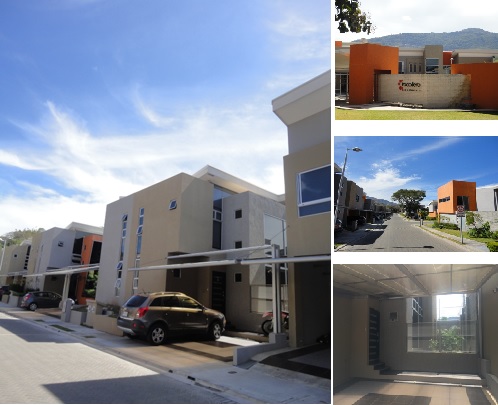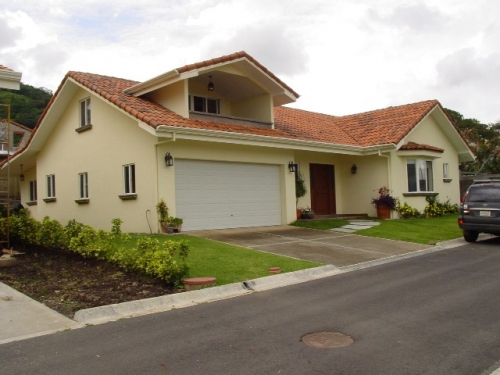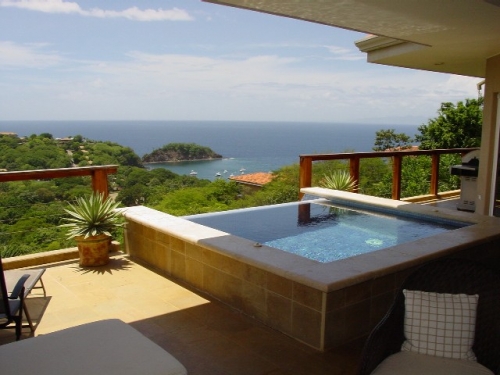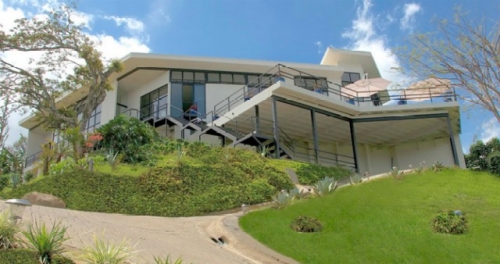Costa Rica Guide
Costa Rica Real Estate
List your property today!
Inclusion of real estate listings at Costa Rica Guide is
absolutely free of charge.
Featured Properties
Costa Rica Guide - Costa Rica Real Estate
Regions - Costa Rica Country Profile
In Costa Rica, contrasts and natural diversity are great.
Few places in the world present, within such a small and accessible area, so many natural variants. In it's length of 51,100 square kilometers, in Costa Rica you will always find a special place to discover.
24.6% of Costa Rican territory is mainly protected under categories such as national parks, biological reserves and national wildlife refuges. No other country in the world has dedicated so much of its territory to the protection of the environment.
Due to its geographical position, Costa Rica is an exuberant biological bridge of botanical and zoological species. Its territory creates a narrow passage that shelters flora and fauna of North America as well as South America, besides a great quantity of endemic species. And it's climate is pleasant always.
The Caribbean
Arriving at the Caribbean is to arrive at the coconut grove, the land where a rich positive life blends with an exquisite flora and fauna.
You can get there via the Braulio Carrillo road, which connects San Jose with Limon. During your trip you will be able to breathe the pure and sweet air of the region. This air, combined with the a beautiful scenery of giant tropical farming lands, like banana, ornamental plants or the popular pejibaye, a native plant of exquisite taste and color.
Let your eyes search through the dense blue Caribbean Sea from Limon's Central Park. From there you will be able to see the historic Uvita island, the land that Christopher Columbus first stepped on in 1502, when he discovered Costa Rica. In this island wonderful sea birds make their nests every year, and surrounding the island, you can find one the most beautiful coral reefs of the country.
In contrast to the tourist infrastructure of the country, the Caribbean coast features wild scenery which hasn't been tampered with by the construction of the small, but warm and welcoming, hotels of the area.
One of the must see locations in the region is Tortuguero. Important scientific research takes place here, such as the study of the egg laying habits of the green sea turtle and the crocodile. It is an interesting location for both the tourist and the scientist.
More to the south, you will find the beaches of Cahuita, Puerto Viejo and Manzanillo with wonderful marine ecosystems. You'll find 35 species of coral, 147 mollusk species, 123 fish species from both salt and fresh water and some 128 marine algae species.
At Puerto Viejo, surfers will enjoy the "Salsa Brava", a world wide famous 40 foot wave. The waves of Bonita, Puerto Viejo and Westfalia beaches plus Uvita Island are equally famous.
In the waters surrounding Punta Uva, Cocles, and Gandoca-Manzanillo you will enjoy the dolphins and your stress will be swept away by the sweeping wings of the beautiful migrating sea birds.
To the south of Limon, the road runs parallel to the sea, extending itself for many miles, granting access to all the Caribbean beaches. These are characterized for their ebony black or ivory white sands, with beautiful estuaries of pure clean water, which provide life for one of Costa Rica's most exuberant groups of marine flora and fauna. These beaches provide peace and tranquility but are also excellent diving or snorkeling spots.
And if you wish to experience sports fishing, the Harpoon, Snook, Fat Snook, Wahoo, Golden, Tripletail, Kingfish, Spanish and zero mackerel, Jack Crevalle and the Barracuda will be awaiting for your arrival.
The Central Pacific
This region of the country is specially attractive to tourists who are in search of candid beaches or daring water rafting trips across rivers. Indeed, the whole coast is made up of spectacular beaches some of which are isolated and permit the visitor to rest and relax.
Other beaches feature plenty of recreational activities and they are located less than two hours from San Jose, Costa Rica's capital. Hence you will arrive quickly and won't miss a minute of the sea breeze and delightful Pacific sun.
On the Central Pacific, you will find excellent surfing spots. Boca Barranca, Tivives y Valor, Escondida, Jaco, Hermosa, Esterillos, Bejuco, Boca Damas, and the beaches that surround Caldera offer excellent conditions for those willing to challenge the waves.
Puntarenas is the largest city in the area, located on the narrow stretch of land overlooking the Gulf of Nicoya. During most of the 19th Century this was Costa Rica's most important port.
Beaches in Puntarenas are flat and made of dark brown sand. They extend themselves along 17km and present ideal conditions for fishing, windsurfing, boogie surfing and offer the best location in Costa Rica for International triathlon events.
At Jaco, one of the favorite beaches of the Central Pacific, you will find international food restaurants along side typical Costa Rican "sodas". Banks, supermarkets and a wide variety of hotels are within easy access.
Long lines of African Palm will provide company while traveling along the highway next to the coast. Their hard red fruit are processed to extract the oil used in the making of raw cosmetic materials and food products.
In Quepos you can rent boats that will take you to enchanting islands located on deep sea. Or you can stay inland and visit Manuel Antonio and enjoy a long night of fun at a local disco dancing to the hot tropical rhythms.
The Central Valley
To most tourists who feel the need for adventure and contact with nature deep inside them, Juan Santamaria International Airport is the entrance point to excitement. So generally, their first contact with this peaceful land is San José, the capital of Costa Rica, central spot for the main museums of the country, and parting point towards experiences that will change your outlook towards life, and the way you co-exist with nature.
San Jose, sitting at an altitude of 1,149 meters above sea level, keeps a mean temperature of about 24 degrees Celsius, having only two marked seasons: the rainy season and the dry season. Things star drying up around November, and get wet again as April comes to an end, when the rainy or "green" season begins anew. Surrounded by "blue-green" mountains, the Central Region is protected by a rich climate of everlasting spring, with quick and always unexpected contrasts.
Ask your travel agency about the one day tours that travel from the Central Valley towards places like Irazú and Poás Volcanoes, the impressive Lankaster Gardens for orchid lovers.
Or maybe an excursion to the torrential waters of the Reventazón River for exciting white water rafting; a cruise to the Pacific Islands, or a visit to Braulio Carrillo National Park where you will be able to admire nature at its best from the tree tops, aboard a funicular.
The Northern Region
While traveling from San Jose to the imposing Northern mountains, you'll enjoy beautiful vistas of varied mountain ranges like the Guanacaste and the Tilaran ranges.
These are separated by the Arenal Dam, which is worldwide sought for because of its wonderful windsurfing conditions, and the small Coter Lake, shaped naturally like a heart. From the Nicaraguan borders to the northern lowlands you can find the seductive Guatuso, San Carlos and Sarapiqui plains.
Among the many attractions to this area, you will see the Arenal volcano, shaped like an almost perfect cone, it provides with awesome magma eruption spectacles that resemble the fire works at the carnival contrasting against the dark night sky.
His next-door neighbors are the Chato and Tenorio volcanoes. Tenorio is made up of four volcanic cones and twin craters, identified as the Montezuma volcano. Currently the Geyser activity presents itself on the northwest side of the volcano, and they are known as Las Quemadas (The Burned).
A kilometer from here is found La Casa, which along with the other spots along the Roble River, make up the "boilers", or thermal focus points. Chato is a truncated cone with an explosive crater at the top, which is currently covered up with a blue-green lagoon.
The Arenal Damming keeps Arenal volcano close company, it being an artificial lake perfect for aquatic sports like windsurfing, since its winds have speeds of up to 72 km per hour.
To the north, the Guatuso area has the Rio Celeste lagoon, a magical place of unequaled natural beauty. On this paradise setting surrounded by precious groves you can imagine the world as it was in the beginning.
Getting to this land of volcanoes, cloudy forests, cataracts and places ideal for long mountainous walks is easy. Some roads are in good condition although many of the main attractions of the area require a four wheel-drive vehicle.
Another interesting site is Monteverde, a town whose history is an example for the rest of the world. The quakers filled the place with love for nature and the world we live in.
Monteverde was the first place in Costa Rica where the Conservation School was founded. Important projects are currently underway there on environmental education, conservation and recycling.
Among the main activities you can perform at Monteverde are long guided walks, a visit to the Butterfly Farm, The orchid farm and Serpent Zoo, canopy trips, horseback ridding and mountain biking.
The North Pacific
Full of sun bathed golden beaches, of varied textures and colors and surrounded by cliffs, the North Pacific coast is full of beautiful vistas. With many its destinations, this region of the Pacific made up primarily by the province of Guanacaste, provides a mayor tourist attraction in the country.
Guanacaste is the land of folklore, music, color and delicious food, particularly the popular "casado". It is also the place to delight yourself in the exquisite taste of the magnificent lobsters, ceviche, and other seafood.
Access to this land of enchantment, five star hotels and small lodgings and hostels; full of exciting activities like deep sea diving, fishing and golf; is easy and direct, using its very own airport, Daniel Oduber International.
Almost every beach in the North Pacific has soft and tranquil waves perfect for swimming and sun bathing. Its abundant ecosystems provide a habitat for many species of fish, shark, Manta ray, and the cute Clown Shrimp. These create wonderful diving and snorkeling spots.
Those with greater experience can expect to find wonderful trips like Palmares Island-Culebra Bay or Coco Beaches and Flamingo.
For those who prefer to stay above the water surface, fishing is a great alternative. The most commonly found fish species are the Marlin, Swordfish, Tuna, Golden fish, Wahoo and the Rooster fish.
And for the surf lovers we recommend the beaches of Potrero Grande, Naranjo, Grande, Tamarindo, Langosta, Avellanas, Negra and Nosara.
The South Pacific
If what you're looking for is an adventure trip, then the South Pacific region is the place for you to visit. It's nature at its outmost expression.
Exuberant and living paradise, with every detail of its green and prolific life unaltered by the existence of mankind. A deep and foaming sea of prism like turquoise waters that slide through white and gray sands.
A sea reminiscent of other times, when nature and life crawled through time at the happy, slow leisurely pace of birds flying across the sky, which are full of white and ethereal clouds. Islands, beaches, trails, Three Toed Sloth, Monkeys, Dantas, felines and birds mesh together with flowers of magical hues.
All this and more are found on the South Pacific, a region that extends itself from the Barú River to the Panamanian frontier, and from the Pacific Coast to the Talamanca Mountain Range.
You can also visit natural private reserves with coordination either with the owners or with the Costarican National Rainforest Reserve.
On the South Pacific you will find Mount Chirripo—at 3,820 meters above sea level—it's the highest point in Costa Rica. If your dream is to feel like a small sand grain in the middle of the wonderful immensity of creation, this is the spot to make that dream come true.
Golfo Dulce constitutes a true tropical paradise. Its water mass is unique in the whole continent. This gulf, where various large tropical rainforest rivers make their final stop, houses great mangrove extensions; in its rich marine life have been discovered nearly 68 species.
Along the South Pacific coast beaches and mangroves, sports like surfing, kayaking, snorkeling and recreational fishing are readily practiced among other activities. And on terra firma you will be able to traverse deeply into relatively unexplored tropical paradise mountains, and so be able to breath a magical pure air, full of rich life.






